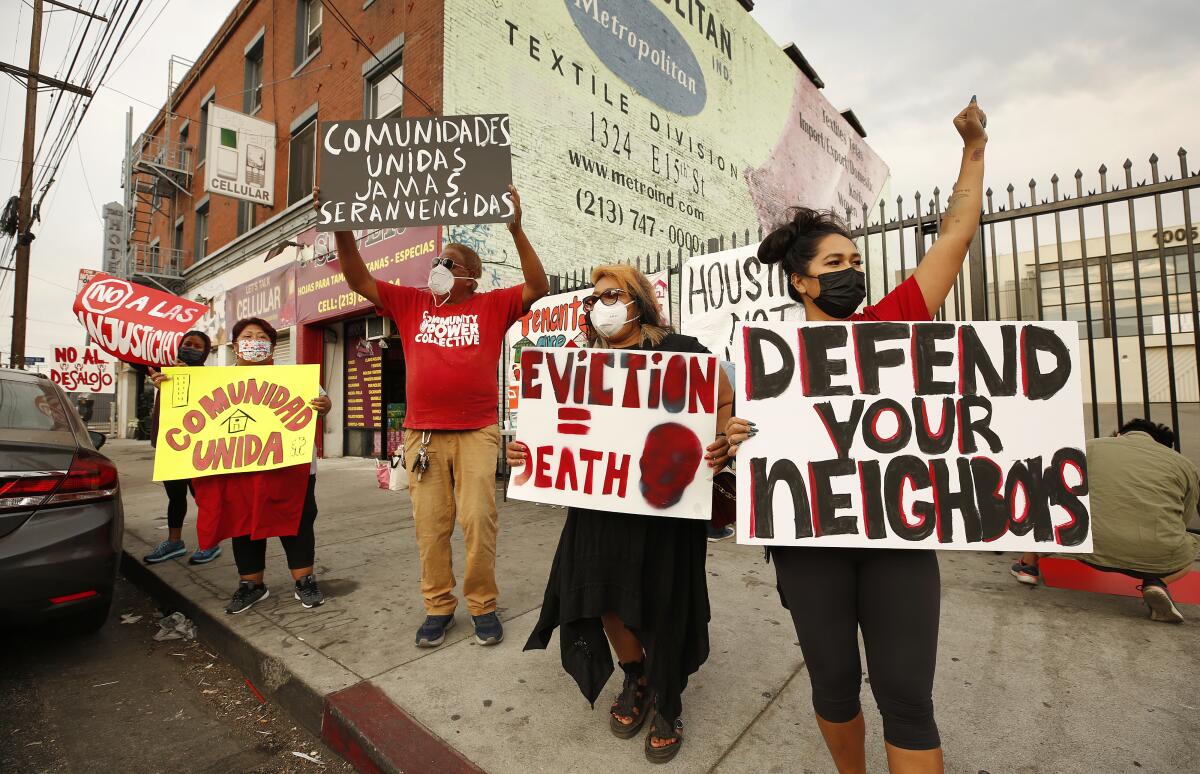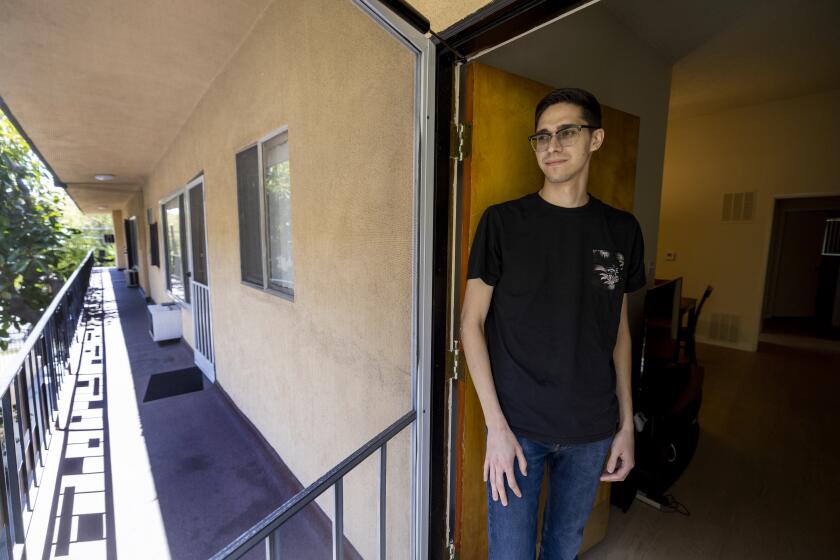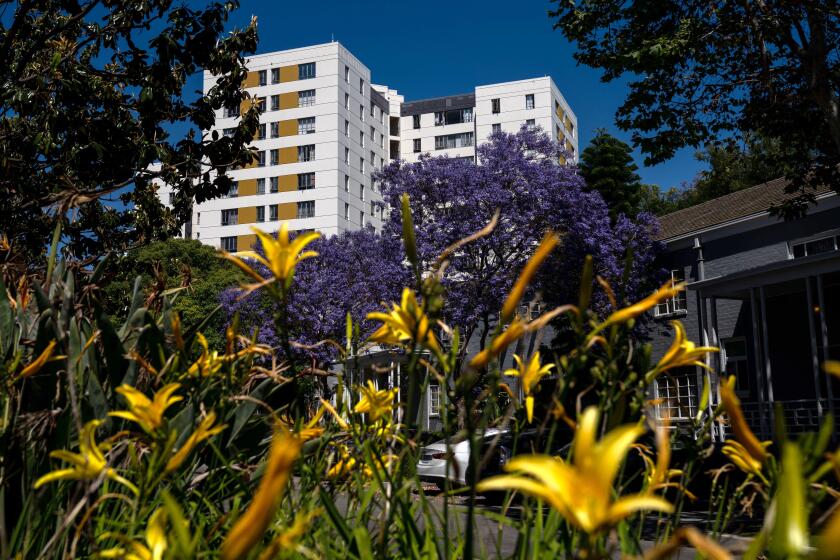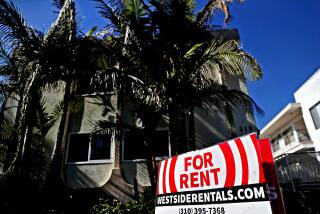COVID eviction bans are lapsing, but other protections for California renters remain

- Share via
Rental housing in Southern California has long been a landlord’s market, with the demand for homes greatly exceeding the supply. That’s true today to an extreme degree, with available units the scarcest they’ve been in recent memory, as The Times reports.
But that doesn’t mean landlords are in a happy place either. During the first two years of the pandemic, California tenants failed to make billions of dollars in rent payments as their wages dropped and expenses rose. To avoid an epic surge in homelessness, state and local officials restricted evictions and lawsuits to collect unpaid rent.
The state sought to make renters and landlords whole by using federal aid to pay the rent debt accrued by tenants hurt by the pandemic. But the payments have been held up by months-long backlogs.
Some of the state restrictions on landlords have now expired, leaving eviction bans and rent deferrals in place only in Los Angeles and other select cities. The result is a patchwork of rules that vary according to where you live, when you started renting your unit and when you missed your rent payments.
To help you navigate this landscape, here are answers to a few of the big questions tenants and landlords face today in Southern California.
The number of apartments available for rent in L.A. County is the lowest it’s been in two decades. The booming job market isn’t helping.
What eviction protections are still in place?
Before addressing eviction limits, it’s worth noting a couple of things. The lease agreement you signed obligates you to pay rent every month. Regardless of any restrictions placed on evictions, you still owe that rent. The landlord, in turn, has a duty to provide you a habitable place to live and cannot harass you or neglect your unit because you have COVID-related unpaid rent.
Now as for eviction protections, your situation will depend on where you live and why you fell behind on your rent.
The city of Los Angeles continues to ban evictions for nonpayment of rent for anyone who has suffered a financial hardship due to COVID-19. According to the city, that would include those who have lost jobs or hours, had to pay more for child care or faced higher medical bills because of the pandemic.
The city’s ban will stay in effect until the local COVID emergency period has ended, the Los Angeles Housing Department says on its website. (The emergency won’t end until June 2 at the earliest.) Nor may landlords conduct “no fault” evictions or oust tenants to take units off the rental market while the emergency is in place.
Once the emergency period ends, renters in L.A. who miss more rent payments can be evicted for failure to pay the rent during post-emergency months. But they cannot be evicted in the near term for failing to pay the rent they owed during the emergency period; instead, the city ordinance gives them 12 months after the emergency ends to pay that debt.
Pasadena, Maywood and Beverly Hills have similar eviction bans. Pasadena will lift its ban June 30, giving tenants six months to repay the debt they ran up during the emergency, city spokeswoman Lisa Derderian said in an email. Maywood’s ordinance also gives tenants six months to repay once its emergency period ends. The Beverly Hills City Council recently voted to end its emergency period May 31; renters there will have six months to pay what they owe now. (The council had voted in September 2020 to give tenants a full year to repay, but that measure appears to be preempted by state law.)
For much of the rest of California, including areas of Los Angeles County outside the city of L.A., the ban on evictions that the state imposed in August 2020 ended as of Oct. 1, 2021. Nevertheless, landlords looking to evict tenants have to abide by state-imposed limits that were designed to serve as a pandemic-relief offramp.
These limits, which apply only to tenants who moved in before Oct. 1, 2021, bar courts from beginning eviction proceedings before July 1 for any tenant with an application pending for rent relief. Most of the relief applications are being considered by the state Housing Is Key program, but Long Beach and a few other jurisdictions are in charge of their own residents’ applications.
Also, landlords couldn’t seek to evict tenants for rent payments missed before April 1, 2022, unless they first applied for rent relief. The state and local programs stopped taking applications March 31.
These programs pay 100% of the COVID-related rent debt accrued by qualified applicants, whose income must be no more than 80% of the area median income ($66,250 for an individual and $94,600 for a family of four in L.A. County). But they have been excruciatingly slow to process applications, and landlords say unqualified claims for relief have sat for months rather than being rejected.
In particular, the state hasn’t been willing to dismiss claims involving renters who don’t file the needed paperwork by the legal deadline, said Jon Swire, a landlord and advisor to real estate investors. That keeps the renter housed, but small landlords have struggled to keep up with their mortgages, utility bills and other expenses in the meantime, he said. Small landlords with federally backed mortgages had the option to pause their loan payments for six months or more, accruing interest charges only, but private lenders were under no obligation to provide similar relief.
Housing Is Key still has tens of thousands of claims awaiting decisions. Alicia Murillo, a spokeswoman for the state Department of Housing and Community Development, said the program has picked up the pace “substantially” since the end of March, adding that “all eligible applications will be paid by June 30.”
Under a state law enacted in March, Assembly Bill 2179, landlords with units outside the city of L.A. can start eviction proceedings immediately if they meet any of the following criteria:
- The state denied rent relief for that unit.
- The landlord applied for rent relief for that unit, but the tenant didn’t submit the required paperwork in a timely fashion.
- The tenant moved in on or after Oct. 1, 2021.
AB 2179 preempts the eviction bans adopted by local governments over the last 1 1/2 years that would have gone into effect before July 1. But it does not block the ban that L.A. County imposes on evictions between July 1 and Dec. 31, 2022, for COVID-related missed rent payments during that period, said attorney Bruce Menke, who represents many small landlords in the county.
One other important point: Under state law, if you complete a declaration that “COVID-19 related financial distress” caused you to fall behind on your rent between March 1, 2020, and Aug. 31, 2020, you can never be evicted for failing to make those payments. If you complete a similar declaration that “COVID-19 related financial distress” caused you to miss payments between Sept. 1, 2020, and Sept. 30, 2021, you can never be evicted for nonpayment if you paid 25% of your rent debt by the end of that period.
State law requires landlords to include blank declaration forms when they send out notices telling tenants to pay off their rent debt or face eviction. Falsely claiming a pandemic-related financial problem can result in a charge of perjury, which is a felony punishable by fines and up to four years in prison.
Totally Worth It
Be your money's boss! Learn how to make a budget and take control of your finances with this eight-week newsletter course.
You may occasionally receive promotional content from the Los Angeles Times.
Can I be sued for unpaid rent?
Even if you’re immune to eviction, you may still be sued for the rent you owe. The timing of such a lawsuit, however, depends on where you live and when you missed your payments.
State law allowed landlords to sue for unpaid rent in small claims court as of Nov. 1, 2021, waiving the usual limit on the size of claims these courts can consider. But landlords cannot charge late fees or interest to people with COVID-related financial hardships for the rent they missed from March 1, 2020, to Sept. 30, 2021.
Nor can landlords go to court to collect rent debt built up during the COVID emergency until the rent deferrals expire, Menke said. Although state law preempts most local ordinances that delayed the due date for unpaid rent, it does not affect the handful that were adopted before Aug. 19, 2020, such as the ones in the cities of Los Angeles and Maywood. In those cities, the only state requirement is that rent deferrals end by Aug. 1, 2023.
Some state lawmakers are asking why there is enough space for golf but not more housing in Southern California.
What about rent increases?
There are two sets of limits on rent increases in California, both of which apply only to the occupants of buildings that are at least 15 years old.
Generally speaking, landlords can set rents on vacant units as high as they want. But once a unit in a building subject to rent control has been leased, the applicable statute — either a 2019 state law (AB 1482) or, in some cities, a local ordinance — limits how much that tenant’s rent can be raised each year.
Los Angeles has the stiffest limit on rent increases. For units built before October 1978, the city has barred any rent increase at all until a year after the COVID emergency period ends.
Other Southern California cities that have local rent control ordinances include Baldwin Park, Beverly Hills, Culver City, Inglewood, Santa Monica and West Hollywood, along with unincorporated L.A. County. Under state law, those limits can apply only to rental units opened to tenants before Feb. 1, 1995. Different cities have different cutoff dates; Santa Monica’s ordinance, for example, applies only to units built before April 10, 1979, while Culver City’s rules apply to rental dwellings built before February 1995.
Most of those local rules allow landlords to raise rents an amount based on the rate of inflation. For example, Culver City allows annual rent increases of 5% whenever the consumer price index is growing by 5% or more, as it is now. Inglewood’s ordinance allows rents to increase by the full amount of inflation in the area, but ties it to the annual rate recorded the previous September. For the Los Angeles area, that’s 4.6%.
For rental units at least 15 years old that are not covered by local rules, AB 1482 limits annual rent increases to 5% plus the area rate of inflation, up to a total of 10%. But it’s not the most recent inflation measurement; instead, it’s based on the annual period from April to April, which hasn’t yet been calculated for April 2022. So at the moment the ceiling on increases in L.A. County is 8.6%, but that’s likely to reach 10% as soon as the 2022 numbers are in.
The state rent controls are set to expire at the end of 2029.
Most renters in L.A. are protected from rent increases at least until May 2023. Here’s how to figure out if you qualify.
Are there other protections for tenants?
The tight rental market might prompt landlords to be choosier when leasing their open units, but state law still limits what they can consider when judging applicants. For starters, California has an extensive anti-discrimination law that bars landlords from shunning or offering inferior terms to people on the basis of their race, sex, religion, source of income or about a dozen other factors.
The state also limits how much landlords can demand as a security deposit. According to the Judicial Council of California, the deposit on an unfurnished unit is capped at twice the amount of the monthly rent, and for a furnished unit it’s three times the rent.
Nor can your landlord apply your security deposit to your pandemic-related rent debt without obtaining your permission in writing, according to a fact sheet prepared by legal groups that represent tenants.
One other protection noted by the fact sheet: If you move while still owing rent due from March 1, 2020, to Sept. 30, 2021, that debt cannot be considered when you apply for a new lease.
The biggest internet service providers in California have all agreed to provide free broadband to low-income households. Now the challenge will be getting them to sign up.
More helpful resources:
- City of Los Angeles renter protection fact sheet
- LawHelpCA, which can connect you with low-cost legal advice
- California courts’ self-help guide to evictions, with guidance for both tenants and landlords
- L.A. County Consumer & Business Affairs guide to county tenant protections
- StayHousedLA.org, which offers information on tenants’ rights
- A guide to tenants’ rights during the pandemic from Bet Tzedek, a nonprofit that provides free legal services to low-income L.A. County residents
About The Times Utility Journalism Team
This article is from The Times’ Utility Journalism Team. Our mission is to be essential to the lives of Southern Californians by publishing information that solves problems, answers questions and helps with decision making. We serve audiences in and around Los Angeles — including current Times subscribers and diverse communities that haven’t historically had their needs met by our coverage.
How can we be useful to you and your community? Email utility (at) latimes.com or one of our journalists: Jon Healey, Ada Tseng, Jessica Roy and Karen Garcia.
More to Read
Totally Worth It
Be your money's boss! Learn how to make a budget and take control of your finances with this eight-week newsletter course.
You may occasionally receive promotional content from the Los Angeles Times.











